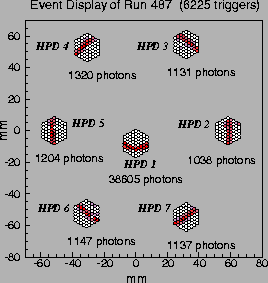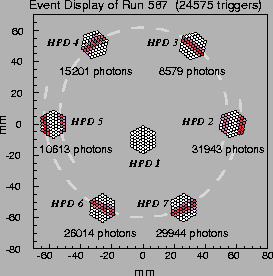A prototype of the downstream RICH detector was tested in the T9 test beam at the CERN SPS during the Spring and Summer of 1997. A planar array of seven 61-pixel HPD's from DEP were used to detect the Cherenkov photons produced in aerogel, air and C4F10 radiators. In configuration-1, fig. 3, of the prototype the light is focussed by a 240 mm focal length mirror which corresponds to a 1/4 scale of the RICH1 detector. A full scale prototype (configuration 2) was also used which has a 1143 mm mirror to focus rings from C4F10 onto an array of six 61-pixel HPD's. This was achieved by adding extension arms to configuration 1.
The 61 pixel HPD has a silicon diode detector
segmented as a hexagonal array with pad dimensions of 2 mm face-to-face.
The HPD was operated at a high voltage of 12kV. Using a pulsed light
emitting diode the complete readout and data acquisition chain was tested.
The pedestal, the single, double and triple photoelectrons peaks were
clearly visible with a signal/noise ratio of
![]() 5.7. Most of
this noise is associated with the input capacitance of the feedthrough
and printed circuit boards.
5.7. Most of
this noise is associated with the input capacitance of the feedthrough
and printed circuit boards.
The test beam provides charged particles of either polarity and the
momentum can be tuned in the range
2 - 15.5 GeV/c. The particle
type is identified by measuring the signal pulse height from a CO2 threshold Cherenkov counter installed 30 m upstream from the
prototype. The prototype vessel was aligned with the beam axis. Charged
particles which provide the trigger are selected using using
scintillation counters, two upstream and two downstream of the vessel.
A photoelectron hit is defined to be a HPD pixel with a signal pulse
height 4![]() above the pedestal mean, where
above the pedestal mean, where ![]() is the rms width
of the pedestal peak.
is the rms width
of the pedestal peak.
Using RICH configuration 1, data were taken with a 10 GeV/c negatively charged beam with 18 mm thickness of aerogel. Fig. 4 shows an arc of a ring on the central HPD, whose radius is compatible with that expected from C4F10. The outer HPD's clearly exhibit a ring which originates from the aerogel radiator.
 |
The number of photoelectrons per triggered event was measured for all
three radiators in the vessel.
For this analysis a threshold of 3![]() was set for
individual pixels and multiple photoelectrons were taken into account.
The mean number of photoelectrons are shown in table 1.
The partial geometrical coverage of the aerogel and gas rings was
calculated from simulation with
was set for
individual pixels and multiple photoelectrons were taken into account.
The mean number of photoelectrons are shown in table 1.
The partial geometrical coverage of the aerogel and gas rings was
calculated from simulation with
![]() 5% uncertainity.
The expected photoelectron yields was calculated from simulation
which included the properties of the aerogel, mirror and photocathode
efficiencies. The overall precision in the expected yield is estimated
to be 15%.
The comparison between observed and expected yields are given in
table 1. The numbers from this preliminary analysis are
compatible within 30%.
5% uncertainity.
The expected photoelectron yields was calculated from simulation
which included the properties of the aerogel, mirror and photocathode
efficiencies. The overall precision in the expected yield is estimated
to be 15%.
The comparison between observed and expected yields are given in
table 1. The numbers from this preliminary analysis are
compatible within 30%.
|
|
The full scale RICH1 prototype was studied using configuration-2. The
longer focal length of the mirror means the
C4F10 ring now
spans the outer 6 HPDs. The event display shown in
fig. 5 is obtained from negatively charged 15.5 GeV/c
momentum beam. The K : ![]() ratio of the triggering particles has been
enhanced to 1 : 2 using the threshold Cherenkov counter.
Fig. 5 shows segments of two rings; an inner ring from
the incident kaons and an outer ring from the pions. It can be seen that
the number of hits observed in HPD 3 is lower than in HPD 4. (Similarly
HPD 5 has fewer hits than HPD 2.) This is because HPD's 3 and 5 have
mylar windows in front of their photocathodes which absorb the UV photons.
ratio of the triggering particles has been
enhanced to 1 : 2 using the threshold Cherenkov counter.
Fig. 5 shows segments of two rings; an inner ring from
the incident kaons and an outer ring from the pions. It can be seen that
the number of hits observed in HPD 3 is lower than in HPD 4. (Similarly
HPD 5 has fewer hits than HPD 2.) This is because HPD's 3 and 5 have
mylar windows in front of their photocathodes which absorb the UV photons.
 |